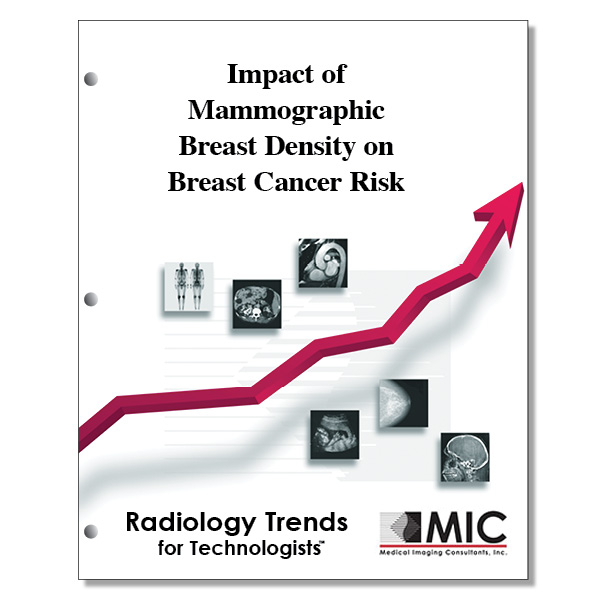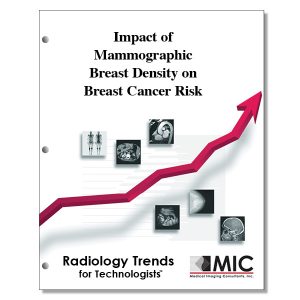

Impact of Mammographic Breast Density on Breast Cancer Risk
The context, scientific evidence, and controversies surrounding the topic of breast density as a risk factor for breast cancer are presented. The current state of evidence regarding supplemental imaging is also considered.
Course ID: Q00470 Category: Radiology Trends for Technologists Modalities: Mammography, MRI, Radiation Therapy, Sonography2.25 |
Satisfaction Guarantee |
$24.00
- Targeted CE
- Outline
- Objectives
Targeted CE per ARRT’s Discipline, Category, and Subcategory classification for enrollments starting after January 28, 2025:
[Note: Discipline-specific Targeted CE credits may be less than the total Category A credits approved for this course.]
Breast Sonography: 0.50
Patient Care: 0.50
Patient Interactions and Management: 0.50
Mammography: 2.25
Patient Care: 1.00
Patient Interactions and Management: 1.00
Image Production: 0.25
Image Acquisition and Quality Assurance: 0.25
Procedures: 1.00
Anatomy, Physiology, and Pathology: 1.00
Magnetic Resonance Imaging: 0.50
Procedures: 0.50
Body: 0.50
Registered Radiologist Assistant: 2.00
Procedures: 2.00
Thoracic Section: 2.00
Sonography: 0.50
Procedures: 0.50
Superficial Structures and Other Sonographic Procedures: 0.50
Outline
- Introduction
- What is Mammographic Density
- Accuracy and Variability of Density Classification
- Breast Density and the Risk for Breast Cancer
- Masking Effect
- Density as an Independent Risk Factor
- Current State of Legislation Regarding Breast Density Notification
- Evidence for Supplemental Screening
- Digital Mammography
- Digital Breast Tomosynthesis
- Whole-Breast US
- MR Imaging
- Expert Guidelines on Supplemental Screening
- The Information Age and Evidence-based Medicine
- Conclusion
Objectives
Upon completion of this course, students will:
- state the number of states with recent legislative changes in regard to patient notification of breast density
- list the critical concepts regarding breast density that radiologists must understand in depth
- define breast density
- express who first described different parenchymal density patterns
- articulate what the acronym BIRADS stands for
- specify the four categories of the BIRADS lexicon
- differentiate between percentages from data about breast density
- describe inter-reader percentages between different studies
- discriminate between classification system types to measure breast density
- describe how positioning of the breast affects objective measurements of breast density
- select the factors that cause breast density to decrease
- state how breast density affects mammographic screening
- contrast mammographic sensitivity and breast density
- describe the method used to make the comparison between mammographic sensitivity and breast density
- define interval cancer
- verbalize the benefit to shorter screening intervals for women with dense breasts
- specify the type of cells most conducive to breast cancer development
- list the major risk factors for breast cancer
- list the breast density classification systems
- name the state where breast density legislation was first passed
- specify the year federal legislation regarding breast density notification was first introduced
- differentiate between imaging characteristics that effect digital mammograms
- express the percentage of facilities in the United States that utilize digital mammography
- state the year digital breast tomosynthesis was approved by the FDA
- describe how digital breast tomosynthesis creates breast images
- list the limiting factors affecting the true impact of digital breast tomosynthesis
- state supplemental screening tools that have not been evaluated via randomized trials
- note the study providing the most relevant data regarding the benefit of whole-breast ultrasound
- list the benefits of automated whole-breast ultrasound
- state the year when the FDA approved automated whole-breast ultrasound
- state the supplemental breast screening modality that is neither recommended for or against in women with the risk factor of dense breasts
- list the obstacles that can limit the use of MR imaging as a breast cancer screening tool
- express screening tests that have been shown to reduce the mortality from breast cancer
- state the driving factors for breast density legislation
- state the benefit of increased information to patients in regard to breast healthcare options
